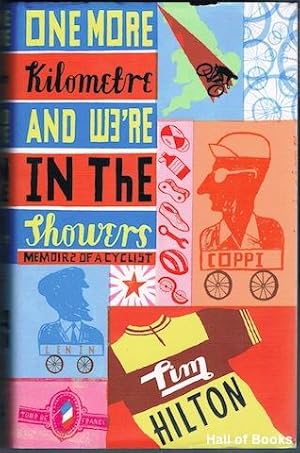
Tim Hilton’s
2004 cycling memoir, One More Kilometre
and We’re in the Showers, is my kind of cycling book. It’s a charming
account of Hilton’s cycling life in Britain in the second half of the twentieth
century, and it covers both his fan’s perspective of continental pro racing as
well as the history of Britain's unique club cycling and cycle-racing cultures.
Hilton’s background as an art critic (biographer of Ruskin), together with his communist
upbringing, gives him a unique perspective on this world. His delightful book
is literary (full of poetry and descriptions of club magazines from the 1950s
and 60s), nostalgic (celebrating the romance and mythology of English cycling’s
past), visual (an image accompanying each short chapter), and chock full of stories
that capture a time and place when cycling mattered in almost every town and village.
A good chunk
of the book (about a third) consists of a fan’s notes that recall the glories
of European pros Hilton followed closely as a young man in the 1950s and 60s: Coppi, Anquetil, Charly Gaul, Jean Robic,
Louison Bobet. Hilton recounts famous races, glorious battles, and tragic
demises of the greats, most of which he followed in French cycling magazines of
the day. Although I can see why Hilton wanted to include these stories, they
are, for me, the least interesting bits in the book; I’ve heard a lot of them
before, most many times. I get that this fandom of youth is an important part
of Hilton’s attachment to cycling, but a lot of these stories feel impersonal,
and I found myself skimming through these sections.
But the rest
of the book is a wonderful—a personal history of twentieth-century British cycling,
of a sort I’ve not encountered before. He
includes chapters on cycling magazines, fall hill rides, End-to-Enders, summer racing on grass tracks, 12-hour
rides, and new-to-me British cycling legends like Reg Harris, Brian Robinson, Beryl
Burton, and Eileen Sheridan.
One of my
favorite chapters is about Frank Patterson’s charming illustrations for Cycling magazine from 1893 to 1952,
which he produced under the pseudonym GHS. These simple drawings capture rural
or village scenes of ye olde England, always with a lone bicyclist pedalling
romantically along the laneway. As Hilton says, there’s something both lovely
and sad about these images of empty villages, reflecting a post-WWI age when
touring writers with lantern-slide images gave lectures on cycling adventures
but that also saw so many places lose all their men and boys in the trenches.
(The great irony, Hilton explains, is that Patterson, who created something
like 26 000 drawings for cycling magazines, was himself not a cyclist at all.)

Hilton also
reminisces fondly about the camaraderie and romance of mid-century club cycling,
with its Sunday runs and time trials, winter social events and club dinners.
The bond was intense among Dartford Wheelers, Tyneside Vagabonds, and
Colchester Rovers. As Hilton recalls, “Cyclists were said to have carried two
photographs with them during their active service: one of a wife or girlfriend,
the other of their club.” The brotherhood is strong in this cycling universe,
and not just among Hilton’s communist friends. He does talk about a few women
riders and even a women’s club (Rosslyn Ladies of the 1930s), but his kind of
social cycling was largely a boys’ club.
As Hilton
explains, the history of British cycle racing is unique because of its
anti-road-racing bias that lasted well beyond the middle of the twentieth
century. In the 1890s, the influential National Cyclists Union forbade the
running of mass-start races, which it deemed chaotic and detrimental to the
reputation of cycling in general. (In general, the NCU was big on touring, not
so big on racing.) That ban lasted for decades, and the dearth of road racing
lead to the development of vigorous track-racing and time-trialling traditions
in British cycling. (It’s worth noting that Hilton’s book pre-dated the rise of
Bradley Wiggins, Mark Cavendish, Chris Froome, and Team Sky, who’ve established
Britain as a road-racing power; in 2004, when this book appeared, the most
successful British road cyclists had been Tom Simpson and David Millar.)
Hilton makes
a compelling case for Sunday morning time trials as the English equivalent of
the Belgian kermesse: “English cycle
racing at its most basic level.” They happened early, 5:30 am, and there were
no spectators to cheer anyone on. “Nobody gives you a clap,” Hilton says, “since
bored girlfriends are sitting in cars, reading the newspaper.” Results were
posted on a bulletin board at the town hall. The whole thing was wrapped up
before most folks even got out of bed.
Time trials,
of course, are not so common in North America, and it took me a while to
understand just how central it has been to British cycling. In one of his more
eloquent moments, Hilton argues time-trialling is the purest form of cycling: a
rider alone with the bike, the road, and the clock. He explains: “There is
nothing like the feeling of riding a bicycle at maximum speed, at dawn, and
alone. Concentration becomes meditation—or something else, almost beyond
thought. It’s unlike anything else in the world of physical effort.”
When the
book first appeared in 2004, Hilton described the English cycling world, as he
knew it, as dying out. Club rides, time trials, point-to-point rides, and
12-hour rides remain important in some English towns, but, as he suggests, the
riders are getting older, with fewer and fewer youngsters taking up the sport.
I wonder if that’s changed at all since the success of Wiggo, Froome, and friends,
but even if there is a British cycling revival, I doubt it looks much like the world Hilton knew and loved.
I think I will add this to my Christmas reading list, Jasper!
ReplyDelete